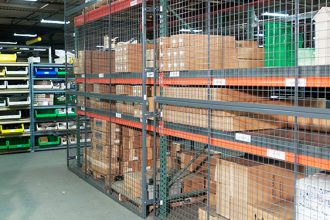5 Protective Guarding Trends Improving Warehouse Safety

While warehouses and distribution centers (DCs) have always prioritized employee safety, they’re increasingly looking for new ways to protect their people. Further, operations managers are simultaneously taking a closer look at ways to enhance the safety of their other assets, including equipment, inventory, and the facility structure itself. Driven by a desire to reduce risk, there are at least five different trends in protective guarding equipment usage that are improving warehouse safety.
“Investing in protective guarding is just like insurance,” explained Dan Lang, Chief Operating Officer for Impact Recovery Systems. The company is a member of the Protective Guarding Manufacturers Association (ProGMA).
“Warehouses and DCs recognize the value of their people, equipment, and other assets,” he continued. “Adding protective guarding equipment is a small price to pay compared to the costs associated with a worker injury, for example.”
Likewise, protective guarding can reduce the costs associated with the replacement or repair of damaged equipment, inventory, or facility structures. Protecting key assets from damage also reduces downtime related to an accident.
Trend No. 1: Protection for Personnel is Expanding
Operations have long issued personal protective equipment to employees to improve warehouse safety. Increasingly, they’re now implementing protective guarding systems to enhance worker safety in designated areas throughout a facility.
“Bollards and guardrail systems are increasingly being installed around areas where personnel are present,” Lang noted. “Previously, floor striping or signage designated these areas, but they lacked a physical barrier. Operations are now installing these protective guarding devices to ensure that a vehicle cannot encroach into those spaces.”
Lang noted a growing number of bollard and guardrail installations to separate pedestrian walkways from areas of forklift traffic. “We’re also seeing a significant increase in placement around entry doors and other spaces where personnel are likely to be,” he said.
Other protective guarding options for these areas include pedestrian and traffic safety gates, retractable belt guarding systems, and safety cages.
Trend No. 2: More Shielding of Automation and Electrical Systems
As companies increasingly invest in automation and electric-powered vehicles — such as forklifts, automatic guided vehicles (AGVs), and autonomous mobile robots (AMRs) — they’re simultaneously investing in protective guarding.
“There’s a trend in companies deploying a lot more automation within their warehouses and DCs. To safeguard the equipment and its power sources, operations are installing physical barriers such as bollards, guardrail systems, and machine guarding,” Lang explained. “If you’re spending hundreds of thousands of dollars on an automated solution, protecting it from vehicle impacts is an easy decision.”
Likewise, the charging stations used to recharge batteries that power manned and autonomous vehicles are also susceptible to impacts. Protecting them from damage is another warehouse safety trend.
“Charging stations are not only expensive, but if one is damaged and out of commission it could reduce the operation’s overall productivity. That’s because the vehicles in the fleet have one less location for charging,” he added. “Companies increasingly recognize the need to install charging station protection.”

Trend No. 3: Increasing Safeguards for Rack-Stored Inventory
Another warehouse safety trend, observed Lang, is the installation of protective devices around racking corners and uprights. Applying rack leg protectors, structural angle rack guards, and guardrail reduces the risk of forklift impact damage to the racking. These solutions also safeguard the inventory stored within it, he said.
“Particularly in operations where high-value inventory is stocked in racking, facilities are installing more equipment to protect the racks,” explained Lang. “Certainly they want to prevent damage to the racking structure, but protecting expensive products is also a driver of this trend.”
Trend No. 4: Enhancing Dock Equipment Protection
As one of the busiest areas of DC or warehouse, the shipping and receiving dock is exceptionally vulnerable to damage from vehicle impacts. Forklift operators are always under pressure to load and unload vehicles faster. Meanwhile, the limited visibility of a loaded fork truck only increases the risk of one clipping a corner, noted Lang.
“Door frames, as well as the dock doors themselves, can sustain damage from a forklift entering or exiting the back of a trailer. Likewise, a tractor-trailer or delivery vehicle backing into the dock can damage the exterior of the facility,” he said. “Adding protective guarding equipment to these dock areas improves warehouse safety.”
To protect those facility structures, operations are leveraging bollards and height restrictors as dock door protection. On the outside of the building, solutions include loading dock bumpers that cushion the impact of a backing trailer as it approaches the building.
Trend No. 5: Flexible Barrier Materials Reduce Impact Damage
While protective barriers such as bollards and guardrails are available in different materials, there’s been an increase in interest in those that can absorb forces of an impact, said Lang.
“Rigid protective systems transfer the energy of an impact to the floor. That can result in damage to the vehicle, the floor, and the protective system itself, leading to necessary repairs,” he explained. “Part of improving warehouse safety, however, is preventing damage. For that reason, more operations are specifying energy absorbing materials to reduce the potential for damage.”
These materials — including rubbers and polymers — deform upon impact, but then return to their original shape. This can limit the extent of any damage that may result from forklift contact.

Need More Ideas to Improve Warehouse Safety?
For further guidance on how to enhance warehouse safety, connect the members of the Protective Guarding Manufacturers Association (ProGMA). ProGMA promotes safety, security, and guarding for people, products, and facilities. The organization offers a variety of educational resources about protective barrier and guarding solutions, as well as develops and promotes industry standards.



